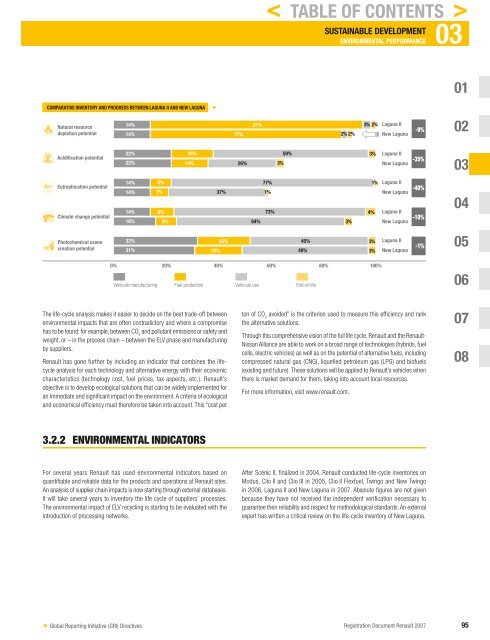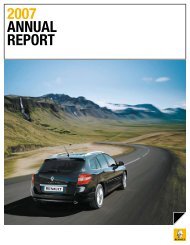2007 Interactive Registration Document - Renault
2007 Interactive Registration Document - Renault
2007 Interactive Registration Document - Renault
Create successful ePaper yourself
Turn your PDF publications into a flip-book with our unique Google optimized e-Paper software.
COMPARATIVE INVENTORY AND PROGRESS BETWEEN LAGUNA II AND NEW LAGUNA ✦<br />
The life-cycle analysis makes it easier to decide on the best trade-off between<br />
environmental impacts that are often contradictory and where a compromise<br />
has to be found: for example, between CO 2 and pollutant emissions or safety and<br />
weight, or – in the process chain – between the ELV phase and manufacturing<br />
by suppliers .<br />
<strong>Renault</strong> has gone further by including an indicator that combines the lifecycle<br />
analysis for each technology and alternative energy with their economic<br />
characteristics (technology cost, fuel prices, tax aspects, etc.). <strong>Renault</strong>’s<br />
objective is to develop ecological solutions that can be widely implemented for<br />
an immediate and signifi cant impact on the environment. A criteria of ecological<br />
and economical effi ciency must therefore be taken into account. This “cost per<br />
3.2.2 ENVIRONMENTAL INDICATORS<br />
For several years <strong>Renault</strong> has used environmental indicators based on<br />
quantifi able and reliable data for the products and operations at <strong>Renault</strong> sites.<br />
An analysis of supplier chain impacts is now starting through external databases.<br />
It will take several years to inventory the life cycle of suppliers’ processes.<br />
The environmental impact of ELV recycling is starting to be evaluated with the<br />
introduction of processing networks.<br />
✦ Global Reporting Initiative (GRI) Directives<br />
< TABLE OF CONTENTS ><br />
SUSTAINABLE DEVELOPMENT 03<br />
ENVIRONMENTAL PERFORMANCE<br />
ton of CO 2 avoided” is the criterion used to measure this effi ciency and rank<br />
the alternative solutions.<br />
Through this comprehensive vision of the full life cycle, <strong>Renault</strong> and the <strong>Renault</strong>-<br />
Nissan Alliance are able to work on a broad range of technologies (hybrids, fuel<br />
cells, electric vehicles) as well as on the potential of alternative fuels, including<br />
compressed natural gas (CNG), liquefi ed petroleum gas (LPG) and biofuels<br />
(existing and future). These solutions will be applied to <strong>Renault</strong>’s vehicles when<br />
there is market demand for them, taking into account local resources.<br />
For more information, visit www.renault.com.<br />
After Scénic II, fi nalized in 2004, <strong>Renault</strong> conducted life-cycle inventories on<br />
Modus, Clio II and Clio III in 2005, Clio II Flexfuel, Twingo and New Twingo<br />
in 2006, Laguna II and New Laguna in <strong>2007</strong>. Absolute fi gures are not given<br />
because they have not received the independent verifi cation necessary to<br />
guarantee their reliability and respect for methodological standards. An external<br />
expert has written a critical review on the life-cycle inventory of New Laguna.<br />
01<br />
02<br />
03<br />
04<br />
05<br />
06<br />
07<br />
08<br />
<strong>Registration</strong> <strong>Document</strong> <strong>Renault</strong> <strong>2007</strong> 95




